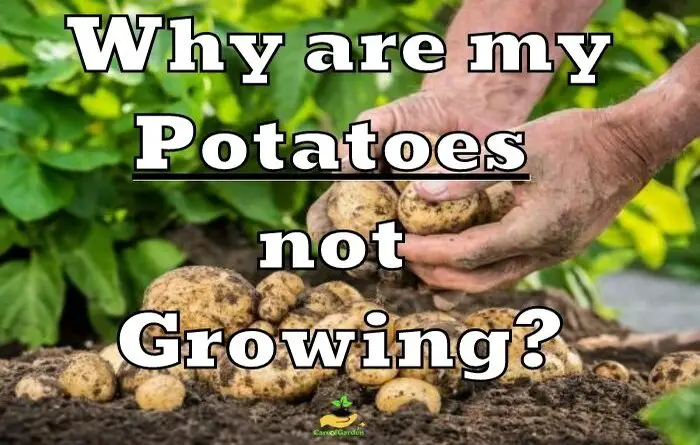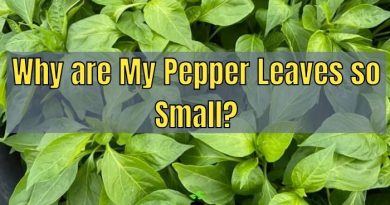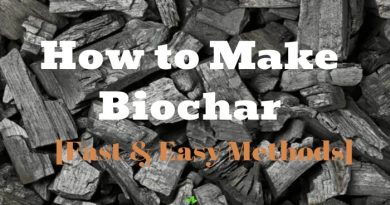Why are my Potatoes not Growing? (Here is the Answer)
Why are my potatoes not growing ? What am I doing wrong? Let’s figure it out together what are the reasons why potatoes do not grow and what we should do about it.
The growth of potatoes will stop due to: bad weather, poor care, lack of nutrients, diseases and also as a result of pest attacks. Stop growing potatoes in hot weather, in the absence of regular watering.
| Why are my Potatoes not Growing: |
|---|
| 1. Nutrient deficiency |
| 2. Lack of water |
| 3. Improper crop rotation |
| 4. Diseases and Pests |
| 5. Wrong soil |
1. Nutrient deficiency
According to my observations, nutrient deficiency is the most common cause why potatoes are not growing. For the development of potatoes, three nutrients are required to be present: nitrogen, phosphorus and potassium.
It is important to know how these nutrients affect potato growth:
| Nutrients | How it affects potato growth |
|---|---|
| Nitrogen and potassium | Increases the size of the tubers, but not their number on the underground stems. |
| Phosphorus | Increases the number of potatoes on the underground stems, but not their tuber mass. |
| Magnesium and Boron | Affect the rate of maturation of tubers and improve their appearance. |
| Copper and Manganese | Are good in feeding potatoes during the growing season and when restoring tops after a drought. |
| Potassium | Is useful for the formation of the tuber. |
Without fertilizers, the soil is quickly depleted, the potatoes take away trace elements and moisture and the soil dries out and becomes hard.
During the first phase of growth, potatoes require a lot of foliage so that the plant can produce a lot of nutrients for the tubers in later stages.
The balance of nitrogen, potassium and phosphorus promotes rapid development of healthy leaves and roots that penetrate deep into the soil, providing potatoes with an abundance of nutrients and water.
During flowering, when the potato tuber begins to swell, it is not necessary to fertilize the potatoes. Applying too much nitrogen during this time will result in no tubers on your potato or reduced potato yields.
If the potatoes have been planted in properly fertile soil and a basic fertilizer: Nitrogen (N), Phosphorus (P) and Potassium (K) (NPK 10-10-10) has been applied when the plants are 20 to 30 cm tall, no further nutrition is required.
Potatoes need a lot of nutrients and especially a lot of nitrogen. Of course, the latter must not be given in excess, for example through artificial fertilizers, because this increases the susceptibility of the tubers to disease and reduces the taste. But the soil must have a minimum of quality and nutrients.
If the pH is low, you can add some ash which provides potassium but not nitrogen.
Here is a table with quantities of nutrients extracted from the soil by the potato crop to produce one ton of tubers:
| Macronutrients | (kg) | Micronutrients | (g) |
| Nitrogen | 2.4 – 8.2 | Boron | 1.4 – 9.0 |
| Phosphor | 0.3 – 1.2 | Copper | 0.6 – 3.9 |
| Potassium | 3.7 – 13.3 | Iron | 32.9 – 136.6 |
| Calcium | 0.4 – 3.0 | Manganese | 5.4 – 24.1 |
| Magnesium | 0.2 – 0.9 | Zinc | 3.4 – 12.0 |
| Sulfur | 0.2 – 1.5 | – | – |
Treatment
To make potatoes grow, it is necessary to apply fertilizers in the fall, spring and during the growing season.
The main thing is not to overdo it with their dosage, apply strictly according to the instructions. Manure can be used, but it must be fully mature, and in any case buried in the winter.
If the fertilization is carried out with fresh manure, or with a spring distribution, just before planting, this does not bring any advantage to the cultivation.
On the contrary, it favors the onset of diseases of the hypogeal of the potato plant and causes a disproportionate vegetative growth, which does not result in an increase in yields.
Therefore it is better to avoid late manuring, if you are unable to intervene in time.
To ensure a successful harvest, farmers top-dress the soil with fertilizer in the fall. They scatter rotted manure over an area of 1 square meter (one square meter equals 10 feet by 10 feet) and apply 2.2 lbs. (1 kg) of potassium nitrate and 11 lbs. (5 kg) of superphosphate.
The following spring, they add ash and dolomite powder to reduce acidity.
Furthermore, the potato is a very demanding cultivar in terms of potassium. This can be done to the ground by adding small amounts of wood ash .
Be careful to go easy on the wood ash, which has the peculiarity of alkalizing the soil. Potato is a crop that avoids alkaline soils, i.e. those with a pH that is too high , therefore use moderation.
Potato growth rate
| Potatoes growth rate | Potato Variety |
|---|---|
| Early varieties: they have a short growing period of 90 to 100 days. | Redstar, Early Rose, Arran Rose, Berber, Duke Of York, Monona, Frieslander, Eersteling. |
| Mid-early varieties: they have a growing period of 100 to 120 days. | Russet, Yukon Gold, Atlantic, Bintje, Norchip, Ratte, Superior, Goldrush, Eigenheimer, Santé. |
| Semi-late varieties: the growing period here is more than 120 days. | White Rose, Purple White, Mesabi Purple, Adirondack, Long Blue, Kennebec, Norland |
| Late varieties: that growing period lasts longer than 150 days. | Kennebec, Russet Burbank, Golden Wonder, Champion, Rosa, Russet Burbank, Desiree, Nicola. |
2. Lack of water
Lack of water and high air temperature prevent the growth of potatoes. Even with a minimum amount of watering, potatoes will yield a crop, but it will be scarce. During drought, potato growth stops and tubers remain small.
Prolonged lack of precipitation also negatively affects the formation of tubers. Drought is especially unfavorable during the period of budding and flowering: due to a lack of moisture, the number of potato tubers is irreversibly reduced.
Even short periods of drought compromise the growth of potatoes, and irrigation is recommended in regions and/or seasons with irregular rainfall distribution. Production is also affected by excess water, as it reduces soil aeration, favors a higher incidence of diseases and leaches mobile nutrients.
If the plants are exposed to heat during tuber growth, their growth stops, and their tubers become small despite later being watered. You can lower the temperature only with frequent watering.
It is often necessary to water potatoes, especially on sandy soil, to ensure a good yield and to avoid potato scabs and growth cracks (the potatoes can crack on the surface if they have lacked water for a period and then suddenly get plenty of water).
Potatoes growing on coarse-grained soil require 1.5-2 cm of water per week if the ball is simply held together during formation. On medium textured soils, potatoes require 3 cm of water when the soil forms a loose ball. Plants in fine-grained soil require 4.5-5 cm of water when the ball is firm and the soil rolls into a ribbon.
The demand for water by plants is mainly dependent on climatic conditions, cultivar and cultivation system. The total crop requirement, including soil evaporation, varies from 250 mm to 550 mm, and can exceed 600 mm for long-cycle cultivars and in hot, dry regions.
Too much water promotes root and tuber deterioration, while too little water, on the other hand, can prevent tuber formation or cause irregularly shaped tubers.
Treatment
To check if your potatoes need extra watering, take a handful of soil and squeeze it into a ball, then try to form a strip of soil with your thumb and fingers.
Potatoes do not require a lot of irrigation , they are resistant plants and they fear excess water.
In general, the drip system is not used in the potato field. Given the tamping it would not be practical, so it can be irrigated by sliding or by rain .
The best time to water is early in the morning, with cooler temperatures. Attention to temperatures is important to prevent diseases like : downy mildew that begins to act at 64°F (18 °C) and if we wet the potato leaves we can favor it.
The periods in which more water is required during potato cultivation are when the first buds appear and then at the end of flowering.
When it is hot, water in the evening during dry weather, as soon as you see the leaves softening. In any case, absolutely avoid wetting the leaves, by using a porous pipe for example. The mounds are used precisely to water between the rows and to direct the water so that it does not touch the leaves.
Finally, about a month before harvest, stop watering altogether.
3. Improper crop rotation
The main mistake that most gardeners make is growing potatoes in the same place for several years in a row. This crop has a high nutrient requirement and depletes the soil very quickly.
Over all these years, pathogenic microorganisms accumulate in the soil, nutrients and micro elements that are most needed by potatoes (especially potassium and phosphorus) are reduced. As a result, potato bushes constantly get sick and tubers become smaller and will not grow.
The potato is normally grown with a three-year rotation in the garden, so if I grow potatoes on a parcel for a year then I will leave other vegetables for at least two years before going back to making potatoes on the same land. This agricultural practice is fundamental in the organic method because it allows to prevent most diseases.
The potato harvest is directly related to crop rotation. Growing a crop in the same place for several years leads to both a decrease in its yield and an increase in diseases and pests.
If potatoes do not grow we need to alternate crop rotation with the following rule: Never to plant potatoes in the same place for more than 3 years in a row, because potato bushes take a lot of nutrients from the soil.
Over the years, pathogenic bacteria have accumulated in the soil, and the supply of nutrients, especially potassium and phosphorus, has decreased significantly.
Bacteria remain in the soil and infect new potato plantings, thus the potatoes become smaller and the yield drops.
Potatoes take root in areas where green manure, cucumbers, cabbage, legumes, beets, and carrots used to grow. Nearby grow lettuce, onions, corn, sorrel.
Treatment
In order to prevent diseases and pests, it is necessary to make a crop rotation – this applies especially to potatoes, cabbage and peas. Crop rotation means that you alternate the crops on the different beds or plots of land.
You should adjust the cycle to suit your consumption of vegetables.
| Crop rotation for Potatoes | Vegetables |
|---|---|
| Good Predecessors | Legumes, cabbage, pumpkin, cucumbers, cereals, beets, greens. |
| Bad Predecessors | Tomatoes, Sunflower. |
| Good Neighbors | Spinach, radish, cabbage, garlic, horseradish, legumes, coriander, lettuce, onion, corn, currant. |
| Bad Neighbors | Tomatoes, turnip, pumpkin, apple tree, celery, cucumber. |
4. Diseases and Pests
Diseases and pests adversely affect potatoes: yields decrease, growth slows down and development stops.
Insect damage can seriously reduce tuber yield. Insects that can cause damage to potato plants include Colorado potato beetles, aphids, leafhoppers, and wireworms (tubers).
Pests
Potatoes not growing due to Colorado potato beetle
The most significant damage to the potatoes tubers, is caused by pests. The larvae of the Colorado potato beetle can leave only stems on the plant, and it will be forced to spend energy on its restoration. The steam and leaflets will grow again, but there will not be enough nutrients available for the tubers, as a result they will not grow and will remain small.
This, if the plant reacts and emits new shoots, it still causes stunted growth. In the most serious situations, however, it causes death. As regards specifically the cultivation of potatoes, the damage generally results in tubers of a small size and scarce number.
In spring, when the soil temperature reaches 57°F (14 °C), the adults emerge from the soil and begin their trophic activity on the plants as well as mating and oviposition.
The damage caused by the Colorado potato beetle to crops is due to the trophic activity of both the adult specimens and the larvae. Colorado beetle is a defoliator insect, that is, it eats all the leaves mercilessly.
If you do not take action, the potato will stop developing, and the tubers will be small.
Treatment
If you inspect the plants carefully during the month of May, you can intercept the first generation of newborn Colorado beetles and remove them, keeping the insect under control without doing any treatment.
As insecticides in organic farming against Colorado beetle, it is possible to use bacillus thuringiensis (Bt) and neem oil. These two treatments can kill Colorado beetle and are allowed in natural crops.
To limit the damage of Colorado potato beetle infestations, in addition to the biological defense methods listed above, it is necessary to act with a rational agronomic practice. This mainly consists in crop rotation , that is, in not repeating in sequence the same cultivation family in the same plot of land.
Diseases
Like other crops, diseases can damage potato plants and prevent tubers from growing. Some typical fungal diseases that are common in potatoes are early blight ( Alternia solani ), late blight ( Phytophthora infestans ).
Early blight and late blight cause the most damage to plant tissues.
Potatoes not growing due to late blight fungus (Phytophthora infestans)
Potato blight is one of the most common fungal diseases among those affecting potato tubers, and it is particularly fearful because if it is not prevented or controlled in time it can compromise the crop.
When infected, the potato stops it’s development. If there is a lot of nitrogen in the soil, the aerial green part develops, and the tubers slow down growth. Manifests itself with brown spots, initially seen on the leaves, then reaches the tuber.
Underdeveloped potato tubers will remain small. Timely hydration and top dressing will protect vegetables from diseases, increase immunity, and help grow a rich harvest.
Treatment
The main measures for the prevention of potato late blight:
- Selection of healthy tubers for planting.
- Application of double doses of phosphate and potash fertilizers.
- High hilling bushes.
- Mowing and harvesting from the area 12-14 days before harvest.
- Digging tubers in dry weather.
The use of treatments with copper, for example with Bordeaux mixture , must be limited to the need and to the doses strictly recommended on the labels of commercial products, avoiding unnecessary and harmful excesses.
Many fungal diseases are spread by water. The garden should be watered in the morning to give the leaves time to dry before night. Avoid walking in the garden when the potato leaves are wet.
Alternatively, the water can be applied in the furrow between the potato rows. This will reduce water present in the leaves and the incidence of diseases.
Potatoes not growing due to early blight (Alternaria solani)
The fungus, Alternaria porri f.sp. solani , is the agent responsible for this disease, which we can directly call Alternaria and which, in addition to tomatoes, also affects the potato.
In contrast to late blight, it attacks older leaves first, where it causes concentric, drier and smaller lesions than late blight, and can cause total plant defoliation, reducing the crop cycle, resulting in the production of small potato tubers and, consequently, in low productivity.
It is favored by high temperatures, above 75°F (24 ºC), and high relative humidity (>90%), therefore more present in crops grown during the summer. Normally, it establishes itself in the field after the period of greater vegetative vigor and spreads through spores carried by the wind.
Treatment
Its control requires fungicide applications that represent more than 10% of the production cost. Choosing the place and time of planting, crop rotation preferably with adequate plant nutrition, among others, play an important role in the integrated control of the disease.
However, it is difficult to obtain success exclusively with the above measures, especially when the culture is inserted in intensive production systems. The use of resistant cultivars is among the most efficient and safest measures to control early blight disease.
5. Wrong soil
Wrong soil is among the top reasons why potatoes do not grow. The best option for growing is light and fertile soil. In no case should you use land with high acidity, as this may affect the taste of potatoes.
Gardeners often make mistakes when preparing potato soil beds. The amount of loose and good soil you give, not the amount of seed potatoes planted, is the main factor why potatoes are not growing.
Grow potatoes in loamy, deep and loose soil, well ventilated but not too rich in fertilizers. The soil for potatoes should be slightly acidic, with a pH level of 4.8 to 5.4.
Potatoes grow best in light and porous soil, as an airy soil gives the plant the best opportunity to grow towards the light and absorb water when it rains.
Less suitable are sandy soils with a low humus content, as well as those that are too clayey which favor water stagnation. The type of soil also influences the form and structure of the potatoes.
On very cloddy soil, the chances of tuber injury during harvesting increase. In loose or medium-textured soils, the tubers develop easily, not finding consistent obstacles. It is therefore advisable to prepare the ground carefully .
Check the quality of your soil by sticking your fingers into the soil and feeling it. The soil should neither feel heavy like clay nor grainy like sand, but like a soft in-between.
Treatment
In this case I recommend that you first measure the pH of the soil. Secondly you will have to be careful when fertilizing (avoiding excess manure or liquid fertilizers for example).
Correct soil preparation is also crucial for a successful potato harvest . You have to reckon with lower yields if you forget to loosen the soil and apply humus before planting the potatoes.
The roots of potato plants can only be spread unhindered in light to medium-heavy, deep soil. The looser the soil, the more tubers will develop. In addition, potatoes are among the heavy feeders who love humus-rich soil.
Therefore, sandy soils are improved with mature manure or compost.
Before planting, be sure to prepare the ground. In autumn, the soil is plowed and fertilized. Humus or manure, potassium nitrate can serve as top dressing, and if the soil has high acidity, then wood ash or dolomite powder is added.
If the soil is clayey and hard, you can cultivate it by spreading a 10 cm thick layer of gravel on top of the soil and then milling or turning the gravel into the soil to make it lighter.
Potato Harvest Yield
| Potato Harvest Yield | Potato Varieties |
|---|---|
| Very High | Coastal Russet, Columbia Russet, Spauldina Rose, Linzer Rose, Red Cara, Redbad, Cascade, Victoria, Norland, Saco, Hudson. |
| High | Atlantic, Acadia Russet, Allagash Russet, Wisconsin Russet, Russet Burbank, Goldrush, Superior White, Superior, Irish Cobbler, Kennebec, Raritan, Sebago, Hilite Russet. |
| Medium | Nora, Wauseon, Nemaruss Russet, Redskin, Redale Red, Arran Banner, Campbell 14, Early Rose, Katahdin, Norchip, Ontario, Oromonte, Monona, Lenape. |
| Low | Karla (1989), Pentland Raven, Populair, Marygold, Rebus, Concorde, Nordak. |
Conclusion
Today you took a closer look at several reasons that adversely affect the growth and development of potato tubers.
By taking action, you will definitely get a good harvest. I hope that the article was useful to you.
Now you know what causes potato to not grow, and you can minimize your losses next year.
There are many people who believe that potatoes can be grown all year round, and for those who believe this, we are here to tell you that it is not possible.
Potatoes are a cool-season crop and will die in the winter if not given special treatment. You will be able to grow potatoes in your garden during the summer months but not throughout the year.
It’s possible to grow potatoes with just potting mix, but you’ll get a better harvest if you grow your potatoes in a mixture of half potting mix and half-compost.
Once you have laid your potatoes, you should expect somewhere between 70-100 days before the potatoes are ready for harvest. However, it depends a lot on the growing conditions and whether they are jumped regularly.




